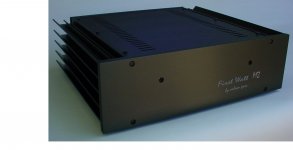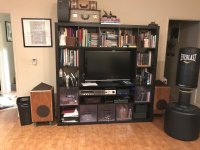It would be helpful to learn the reason why (or perhaps arrive at the conclusion that thermal solution's 3% conclusion is hot air )
Pass DIY Addict
Joined 2000
Paid Member
I hope we can find a reason why Zen mod's direct experience differs from Thermal solution's predictions. It would be helpful to learn the reason why (or perhaps arrive at the conclusion that thermal solution's 3% conclusion is hot air )
Here are a few possibilities for Zen's observation (which I trust completely) and the manurfacturer-supplied article (which I take with a 10-lb bag of salt):
The article (interesting read by the way, thanks Jim!) has no ACTUAL temperature data. What was the ambient temp? What was the thermal rise of the sink? The power output device? I notice this paper was produced by "Thermal Solutions, Inc." thus they are a heat sink manufacturer (or closely related). It seems to be "industry standard" (which varies and is often unstated) to measure heat sink dissipation at somewhere near 80c, not the "paltry" 50c that we tend to live by. This is a big difference in thermal behavior. The article talks about watts dissipated and fin length, but provides no ACTUAL data: What specific temperature was measured? The data they provide for heat sink dimensions are 50mm by 100mm with a fin length of 50mm. This sounds like something I'd mount a rectifier to (wimpy duty), not something that I'd attach 100w worth of mosfet output power to. That sink is just too small for it to provide any meaningful data in our specific context.
My big Aleph-X amps have sinks that measure 18" wide by 10" tall with fins that are near 2" deep on each side and they radiate near 400w of heat into a cool (15c) environment. Turn these puppies on their side and I'll lose a very nice amp to over heating.
ok, your space is limited, in consequence airflow too.
Have you more heat sink area on your horizontal configuration ?
having distribution plate between your hot source and your heat sink in way to maximise the surface area on heat sink side.
For efficiency thinking removing hot air in priority to add fresh air. (fan or not)
Have you more heat sink area on your horizontal configuration ?
having distribution plate between your hot source and your heat sink in way to maximise the surface area on heat sink side.
For efficiency thinking removing hot air in priority to add fresh air. (fan or not)
The concerns raised about applying thermal solutions results to audio heatsinks are interesting.
Several raised concern about whether there would be adequate space. I would expect 50-75 mm of clearance from the top of the fins. I expect this amount of space would decrease the heat dissipation somewhat but not drastically.
Also, I am looking at 210x 400 mm of heatsink per channel, the same amount as a large DIY audio store deluxe 5U. Mounted in the traditional vertical orientation this would be enough for any amp I am looking to house in this chassis (F4, 5, 6, Honey Badger or Mofo).
If I am expecting results similar to the thermal solutions 3% reduction, there should be more than enough heatsink. However, if I get results similar to Zen mods it may not be enough. I think it would be safe to go for it, as if it does not work, I can either work out a solution with a fan, or build a more traditional class A chassis using the same heatsinks.
Several raised concern about whether there would be adequate space. I would expect 50-75 mm of clearance from the top of the fins. I expect this amount of space would decrease the heat dissipation somewhat but not drastically.
Also, I am looking at 210x 400 mm of heatsink per channel, the same amount as a large DIY audio store deluxe 5U. Mounted in the traditional vertical orientation this would be enough for any amp I am looking to house in this chassis (F4, 5, 6, Honey Badger or Mofo).
If I am expecting results similar to the thermal solutions 3% reduction, there should be more than enough heatsink. However, if I get results similar to Zen mods it may not be enough. I think it would be safe to go for it, as if it does not work, I can either work out a solution with a fan, or build a more traditional class A chassis using the same heatsinks.
Pass DIY Addict
Joined 2000
Paid Member
You should be thinking more along the lines of 8-10" of clearance above your completed amp for adequate (natural) air circulation. This conversation would benefit from having a more detailed understanding of exactly where this amp will live. A photo would be best.
If you are looking at less than 8-10" clearance above, several inches to each side, and even an inch or two underneath (longer legs) you should be thinking about a forced air solution.
If you are looking at less than 8-10" clearance above, several inches to each side, and even an inch or two underneath (longer legs) you should be thinking about a forced air solution.
The concerns raised about applying thermal solutions results to audio heatsinks are interesting.
Several raised concern about whether there would be adequate space. I would expect 50-75 mm of clearance from the top of the fins. I expect this amount of space would decrease the heat dissipation somewhat but not drastically.
Also, I am looking at 210x 400 mm of heatsink per channel, the same amount as a large DIY audio store deluxe 5U. Mounted in the traditional vertical orientation this would be enough for any amp I am looking to house in this chassis (F4, 5, 6, Honey Badger or Mofo).
If I am expecting results similar to the thermal solutions 3% reduction, there should be more than enough heatsink. However, if I get results similar to Zen mods it may not be enough. I think it would be safe to go for it, as if it does not work, I can either work out a solution with a fan, or build a more traditional class A chassis using the same heatsinks.
Assuming standard bias voltage of .6v and excellent thermal coupling, look for heatsink temps around 118 deg F right on the other side of the MOSFET. In the manual for the F5 Nelson says they run at 132 (50C). I think they'll be much higher with no air flow.
Our member EUVL has most of the answers:
Linear Audio | your tech audio resource
I will make the article available on request, send me PM.
Jan
Linear Audio | your tech audio resource
I will make the article available on request, send me PM.
Jan
You should be thinking more along the lines of 8-10" of clearance above your completed amp for adequate (natural) air circulation. This conversation would benefit from having a more detailed understanding of exactly where this amp will live. A photo would be best.
If you are looking at less than 8-10" clearance above, several inches to each side, and even an inch or two underneath (longer legs) you should be thinking about a forced air solution.
OK, so several inches does not count as plenty of clearance.
Pass DIY Addict
Joined 2000
Paid Member
Inside one of those cubby holes looks like a bad idea to me. I do, however, see space on top of your equipment rack as well as on top of each of your speakers that stand on the floor.
A little creativity might reveal other options. All of my equipment is in an adjacent room. The only audio gear in the family room is a television, a set of speakers, and an infra-red remote eye.
A little creativity might reveal other options. All of my equipment is in an adjacent room. The only audio gear in the family room is a television, a set of speakers, and an infra-red remote eye.
a photo of the location.
I'm more competent at woodwork and metalwork than electronics. Though casework is inherently time consuming if your tools are limited, it poses less a challenge than electronics work for me.
Since a power amp has no controls on the front just put a standard F5 on top and put a picture of the spouse in front of it.
- Status
- This old topic is closed. If you want to reopen this topic, contact a moderator using the "Report Post" button.
- Home
- Amplifiers
- Pass Labs
- Heat sink orientation help

